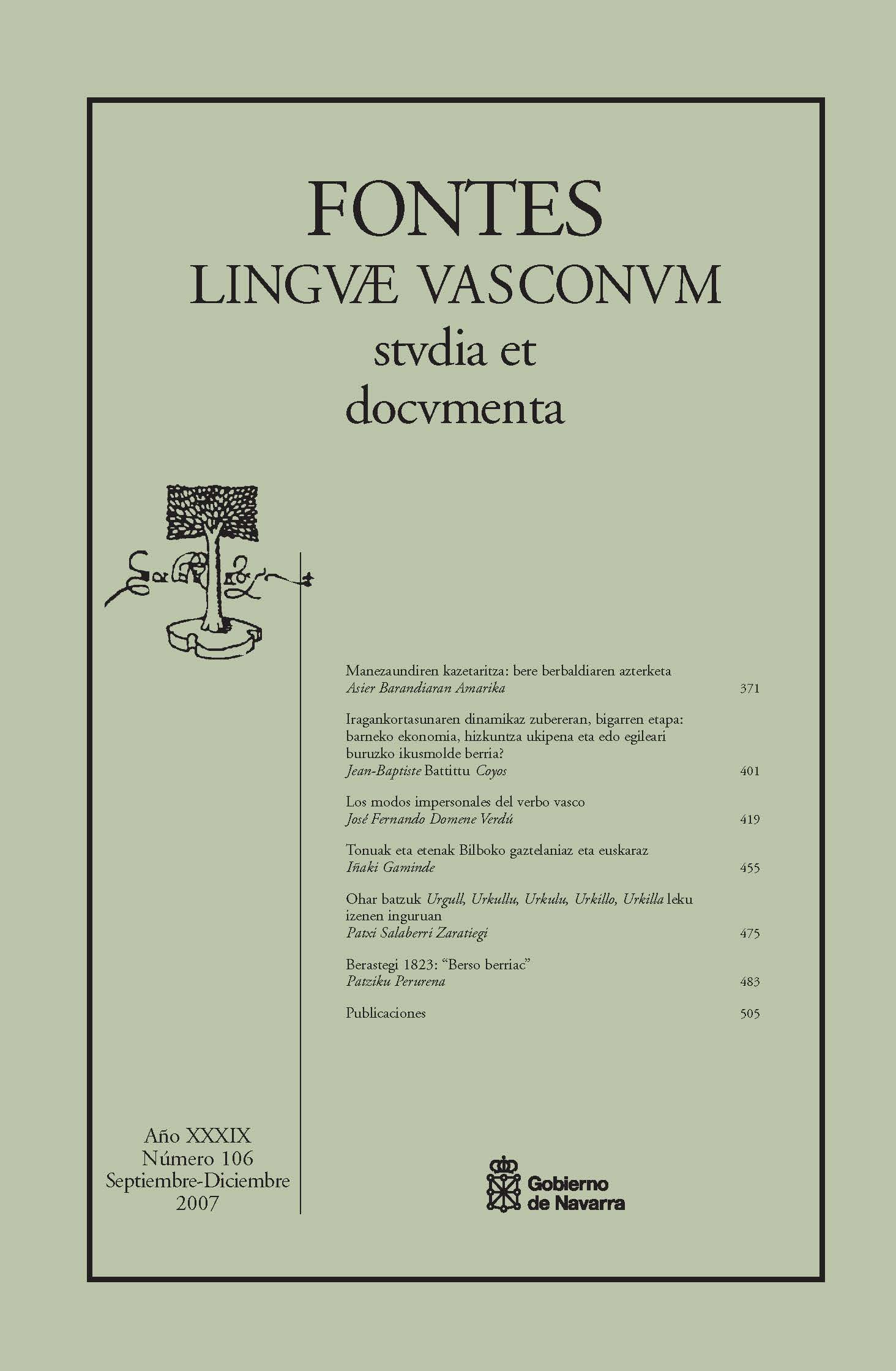Iragankortasunaren dinamikaz zubereran, bigarren etapa: barneko ekonomia, hizkuntza ukipena eta edo egileari buruzko ikusmolde berria [Transitivity dynamic in Souletine dialect: internal economy, language contact or a new view about the agent?]
Abstract
This article is the second part of a study devoted to certain bivalent verbs of Souletine Basque dialect, called “bivalent verbs with double casual marking” (FLV, 100, 2005). At the present time in Basque Souletine dialect, there are two different ways to construct more than thirty bivalent verbs and retain the same meaning. They have a double case and indicial marking with change of the auxiliary. They are rather low verbs in a semantic scale of transitivity. Constructions with izan “to be” are rather used by older speakers, while younger Bascophones tend to use constructions with *edün “to have”. The conditioning of a linguistic variation and of a linguistic change is generally complex and difficult to update. The postulated evolution could be due to:
– the internal economy of the language, analogical attraction, since the two structures in competition already co-exist; substitution due to the weak functional output of construction with izan, and memory-saving without loss of the distinction of the two arguments;
– language contact: intra-linguistic contact between the dialect and Unified Basque or others Basque varieties for the construction of some verbs, and contact between languages, French/Basque (indirect loan translations);
– or, this being the most daring assumption, due to an external factor like the evolution of the way of life and thought in which the argument having to do with experience is seen more and more like an agent.
The difficulty of this research is found in the necessity of validating these potential factors and then of evaluating the respective weight of them, according to the verbs considered. As a conclusion, a summary table of the studied factors is proposed.
##about.statistics##
References
BOSSONG Georg, 1992, Interaction entre fonctions actancielles et sémantique des actants, Programme in Language Typology, European Science Foundation, Eurotyp Working papers, n° 4.
BOSSONG Georg, 1998, "Le marquage de l'expérient dans les langues d'Europe", in Actance et Valence dans les Langues de l'Europe, Jack Feuillet (ed.), Berlin-New-York, Mouton de Gruyter, 259-294. https://doi.org/10.1515/9783110804485.259
BOSSONG Georg, 2003, "Nominal and / or verbal marking of central actants", in Romance objects. Transitivity in Romance languages, Giuliana Fiorentini (ed.), Berlin-New-York, Mouton de Gruyter, 17-47. https://doi.org/10.1515/9783110919837.17
CHAMBERS J. K., 2004 (2002), "Patterns of Variation including Change", in The Handbook of Language Variation and Change, Chambers J. K., Trudgill Peter, Schilling-Estes Natalie (eds.), 349-372. https://doi.org/10.1111/b.9781405116923.2003.00020.x
CHAMBERS J. K., TRUDGILL Peter, SCHILLING-ESTES Natalie (eds.), 2004 (2002), The Handbook of Language Variation and Change, Malden (USA)-Oxford (UK)-Carlton (Australia), Blackwell Publishing https://doi.org/10.1002/9780470756591
COYOS Jean-Baptiste, 1999, Le parler basque souletin des Arbailles-Une approche de l'ergativité, Paris, L'Harmattan.
COYOS Jean-Baptiste, 2005, "Iragankortasunaren dinamikaz zubereran: kasu adierazpen bikoitzekiko baliobi ko aditzen ikerketaren lehen etapa", Fontes Linguae Vasconum, 100, Iruñea, Navarra, Gobierno de Navarra, 633-660.
COYOS Jean-Baptiste, 2007, "Zubereraren bilakaeraz adibide batzuk", Mendebaldeak badu Ekialdea. Zuberoa:
Hizkuntza, literatura eta etorkizuna, XI. Jardunaldiak, Bilbo, Mendebalde Kultur Alkartea, 21-38.
CROFT William & CRUSE D. Alan, 2004, Cognitive Linguistics, Cambridge (UK), Cambridge University Press. https://doi.org/10.1017/CBO9780511803864
DESCLÈS Jean-Pierre, 1998, "Transitivité sémantique Transitivité syntaxique", in André
ROUSSEAU (ed.), La transitivité, Villeneuve d'Ascq, Presses Universitaires du Septentrion, 161-180.
DOWTY David, 1991, "Thematic proto-roles and argument relations", Language, 67/3, Baltimore (USA), 547-619. https://doi.org/10.1353/lan.1991.0021
HADDICAN William F., 2005, "Part I Language Variation and Change in Oiartzun", in Aspects
of Language Variation and Change in Contemporary Basque, doctoral dissertation / tesi, www.soziolinguistika.org.
HOPPER Paul J., THOMPSON Sandra A., 1980, "Transitivity in Grammar and Discourse", Language, 56, 2, Baltimore, W. Bright, 251-299. https://doi.org/10.1353/lan.1980.0017
HOUDEBINE Anne-Marie, 1985, "Pour une linguistique synchronique dynamique", La Linguistique, 21, Paris, Presses Universitaires de France, 7-36.
LABOV William, 1976 (1973), Sociolinguistique [Sociolinguistic Patterns], Paris, Les Editions de Minuit.
LÜTDKE Helmut, 1985, "Diachronic irreversibility in word-formation and semantics", in Historical Semantics Historical Word-Formation, Jacek Fisiak (ed.), Berlin-New YorkAmsterdam, Mouton Publishers, 355-366.
LÜTDKE Helmut, 1986, "Théorie du changement langagier", La Linguistique, 22, 1, Paris, Presses Universitaires de France, 3-46.
LÜTDKE Helmut, 1989, "Invisible-hand processes and the universal laws of language change", in Language Change Contribution to the Study of Its Causes, Leiv Egil Breivik and Erns Håkon Jahr (ed.), Berlin-New York, Mouton de Gruyter, 131-136.
MARTINET André, 1955 (1980-2005), Economie des changements phonétiques. Traité de phonologie diachronique, Bern, A. Francke / Paris, Maisonneuve et Larose.
MARTINET André, 1975 (1973), "Diachronie et synchronie dynamique", Evolution des langues et reconstruction, Paris, Presses Universitaires de France, 5-10.
MARTINET André, 1989 (1984), "De la synchronie dynamique à la diachronie", Fonction et dynamique des langues, Paris, Armand Colin, 47-52.
MARTINET André, 1990, "La synchronie dynamique", La Linguistique, 26, 2, Paris, Presses Universitaires de France, 13-23.
ROUSSEAU André (éd.), 1998, La transitivité, Villeneuve d'Ascq (France), Presses Universitaires du Septentrion.
SWIGGERS Pierre et VERLEYEN Stijn, 2002, "Principes fonctionnels (dans l'explication) du changement linguistique", La Linguistique, 38, 2, Paris, Presses Universitaires de France, 105-115. https://doi.org/10.3917/ling.382.0105
Copyright (c) 2007 Jean-Baptiste "Battittu" Coyos (Autor/a)

This work is licensed under a Creative Commons Attribution-NonCommercial 4.0 International License.







